

The 'underground forests’ that are bringing deserts to life. A Forest Full of Food. Hugelkultur: the ultimate raised garden beds. Raised garden bed hugelkultur after one month raised garden bed hugelkultur after one year raised garden bed hugelkultur after two years raised garden bed hugelkultur after twenty years.

Institute of Urban Ecology. Hardiness zone. Temperature scale of hardiness zones, showing the average annual minimum temperature in degrees Celsius.
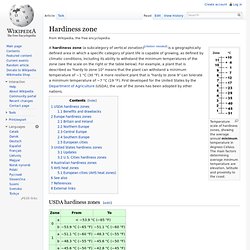
The main factors determining average minimum temperature are elevation, latitude and proximity to the coast. A hardiness zone (a subcategory of vertical zonation)[citation needed] is a geographically defined area in which a specific category of plant life is capable of growing, as defined by climatic conditions, including its ability to withstand the minimum temperatures of the zone (see the scale on the right or the table below).
Dill. Dill (Anethum graveolens), is either a perennial or annual herb.

It is the sole species of the genus Anethum. Growth[edit] Dill grows to 40–60 cm (16–24 in), with slender stems and alternate, finely divided, softly delicate leaves 10–20 cm (3.9–7.9 in) long. The ultimate leaf divisions are 1–2 mm (0.039–0.079 in) broad, slightly broader than the similar leaves of fennel, which are threadlike, less than 1 mm (0.039 in) broad, but harder in texture. The flowers are white to yellow, in small umbels 2–9 cm (0.79–3.54 in) diameter. Etymology[edit] The name "dill" comes from Old English dile, a West Germanic word of unknown origin [1] the plant having the carminative property of relieving gas[citation needed].
Culinary use[edit] Permaculture Videos. Bill Mollison Permaculture Lecture Series On-Line. Free Permaculture Design Course Videos. Alaska Permaculture - Alaska's Permaculture Community. Update: 36 Hour Permaculture Course - Online and Free! (permaculture design forum at permies) Poultry Breeds - Khaki Campbell Duck. A Quick Guide to Raising Ducks - Sustainable Farming. People are always giving us something.
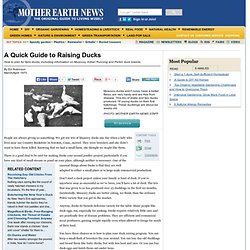
We got our trio of Muscovy ducks one day when a lady who lives near our Country Bookstore in Noroton, Conn., moved. They were breeders and she didn't want to have them killed. Knowing that we had a small farm, she thought we might like them. There is a good deal to be said for making ducks your second poultry project, particularly if you have any kind of small stream or pond on your place, although neither is necessary. One of the unusual things about ducks is that they are well adapted to either a small place or to large-scale commercial production. Six Duck Breeds For Your Small Farm. Runner ducks Photo credit: Wikipedia CC If you are considering adding ducks to your small farm you will be making a wise choice, as they will be pleasant companions and entertain you daily while providing pest control, manure for your soil, meat, eggs, down and feathers, and left-over grease that can be used for cooking.

How many people/acre? Abe Connally wrote: Brenda Groth wrote: Vegans obviously will use less acerage than those that eat dairy and eggs, and even less than meat eaters.

(I am not touting vegans here as I eat meat at nearly every meal)..just making an observation. Crop Yield Verification. Food and Permaculture by David Blume. Food and Permaculture.
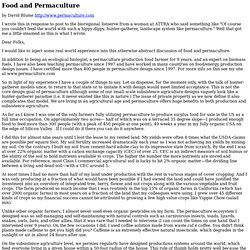
7 Badass Bavarian Foods You Must Try. Bavarian food doesn’t f#ck around.
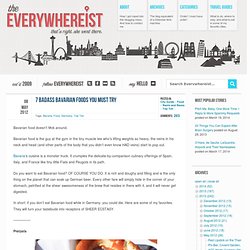
Bavarian food is the guy at the gym in the tiny muscle tee who’s lifting weights so heavy, the veins in his neck and head (and other parts of the body that you didn’t even know HAD veins) start to pop out. Bavaria‘s cuisine is a monster truck. It crumples the delicate-by-comparison culinary offerings of Spain, Italy, and France like tiny little Fiats and Peugots in its path. Do you want to eat Bavarian food? Plateau_subsistence_HNAI.pdf. Zasada/final - gtr_nc217page 066.pdf. Traditional Plant Foods of canadian indigenous peoples, Nutrition, Botany and Use.
Almost all major groups of wild plants in Canada have edible members that are reported to have been used by Indigenous People.
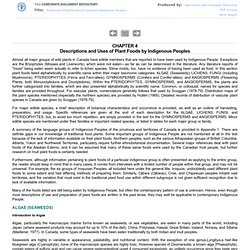
Exceptions are the Bryophytes (Mosses and Liverworts), which were not eaten—as far as can be determined in the literature. Any literature reports of "moss" being eaten seem actually to refer to lichen species. Slime molds, too, have no evidence of having been used as food. Suzuki's Top 10 Sustainable Seafood Picks.
It's not uncommon to hear David Suzuki say, I am fish.
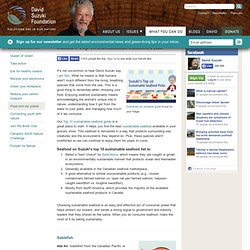
What he means is that humans aren't much different from the living, breathing species that come from the sea. This is a good thing to remember when choosing your food. Pacific Fin Fish Species. Stories in the News - Ketchikan, Alaska - June Allen. The First Sign of Spring: OOLIGAN A biography of a special fish By June Allen February 17, 2003 Monday - 1:00 pm For many years the late Bill Baker, Ketchikan's Hometown Reporter, would open his newscast one late winter day each year and say with just a hint of excitement, in his familiar nasal monotone. "Spring is officially here. Bert May's Satellite is in with a load of ooligan.
" Ooligan enthusiasts hurried to the docks to buy their annual supply. Bill Baker's gone now. Thaleichthys pacificus Photo courtesy University of Oregon. NOAA - FishWatch: Sablefish. Sablefish might be new to you, but U.S. and Canadian fishermen have been harvesting this tasty, buttery fish since the late 1800s. With continued scientific monitoring of the resource and careful management of our fisheries, we should be able to enjoy sablefish for generations to come.
The U.S. sablefish fishery hasn't always been sustainable—in Alaska, heavy fishing from foreign fleets depleted the population in the 1970s. With the implementation of the Magnuson-Stevens Act in 1976, the United States took back control of our waters, phasing out foreign fishing and restricting the amount of sablefish that could be caught. Alaska Fisheries Science Center Homepage. Alaska_Sablefish_Assessment_for_2011_FINAL.docx - GOAsablefish.pdf. How to Make Your Own Yogurt. My brother showed us how to make yogurt back in the '70's. It was fun, and it really did taste great. All things old are new again! You were misled. Per federal law, every Grade A dairy farm's daily production is sampled for antibiotic residue, every truck of milk is tested for antibiotic residue before it is unloaded at the processor. Antibiotics-contaminated milk leaving the farm is very, very rare, according to the National Milk Drug Residue Database about 1 in 4000 truckloads tested positive, and, also per federal law, those loads of milk were removed from the human food chain.
Labrador tea. Close up of a Labrador Tea flower, found in the alpine zone of northern New Hampshire. Ledum latifolium, an earlier name for Rhododendron groenlandicum Labrador tea is an herbal tea (not a true tea) made from three closely related species: Regional cuisines of medieval Europe. The regional cuisines of medieval Europe were the results of differences in climate, seasonal food variations, political administration and religious customs that varied across the continent. Medieval cuisine. A group of travellers sharing a simple meal of bread and drink; Livre du roi Modus et de la reine Ratio, 14th century. A type of refined cooking developed in the late Middle Ages that set the standard among the nobility all over Europe. Vancouver Island Tayberry Plant -20 Seeds- CrossBreed of Raspberry / Blackberry. 12 German Sausages, From Brilliant to Wonderful. Introducing the most common German sausages. Radicchio. American Livestock Breeds Conservancy: Conservation Priority Lists.
American Livestock Breeds Conservancy: Campbell Duck. Mostly Minis Registered Nubian and Pygmy Goats Armstrong, BC Breeder. The Little Red Hatchery. Russian Orloff (Critcally Endangered Chicken Breed) - Spring Hill Heritage Poultry Conservatory. Russian Orloff Chicken. 5 of 5 | September 26, 2012 at 03:20 PMA friendly and hardy large bird, can be used for meat and/or laying purposes but is not a cost efficient food source. Pros: Extremely friendly, cold hardy, large, lay eggs and can be considered a meat bird. The Russian Orloff. The Orloff Club. Orloff Chickens. Orloff (chicken) The Orloff is a breed of chicken named after Alexei Grigoryevich Orlov, a Russian Count. How To Care My Russian Orloff Chick? Russian Orloff. Icelandic or Viking Hen. Russian orloff chicken - $30 (burnaby ) for sale in Vancouver, British Columbia Classifieds - CanadianListed.com. AlbertaChickensEtc / Russian Orloff Club. The Russian Orloff Society. American Livestock Breeds Conservancy - Links.
Everything Loves to Eat Chicken: A Guide to Securing Your Coop from Predators. California « Seaweeds of the Pacific Northwest. The Power of Community: How Cuba Survived Peak Oil (2006. Homesteading Self Sufficiency Survival.
Edible Landscaping Made Easy. Chill your beer without using any electricity. Trust Me, I'm an "Eco-Designer" Camp Food Planning: Supplemental Hunting/Gathering. Native Food Plants of the Pacific Northwest: Seaweed and Kelp. Traditional Food Preservation Techniques - The Red Cedar Volunteer Resource. Vegetable Gardens - The Red Cedar Volunteer Resource. Camp Food Plan: Perennial Food Sources. Camp Food Plan: Annual Food Sources. Homestead Ideas. Keeping Animals - The Red Cedar Volunteer Resource. Beekeeping - The Red Cedar Volunteer Resource. Camp Food Plan: Domestic Animal Food Sources.